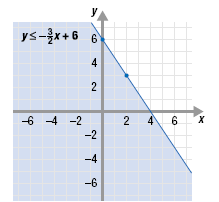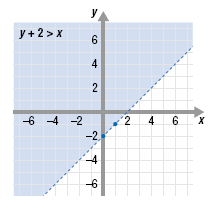|
Solving Systems of Linear InequalitiesExample Graph the system of inequalities.
Solution Step 1 Solve the first inequality for y. Then graph the inequality. To graph the inequality
• The y-intercept is (0, 6). Plot (0, 6). • The slope is
For the inequality
• To represent “equal to,†draw a solid line through (0, 6) and (2, 3). • To represent “less than,†shade the region below the line.
Note: If you use the slope to plot several more points, it will be easier to draw the line. Step 2 Solve the second inequality for y. Then graph the inequality. To solve for y, subtract 2 from both sides of y + 2 > x. The result is y > x - 2. To graph y > x - 2, first graph the equation y = x - 2. • The y-intercept is (0, -2). Plot (0, -2). • The slope is
For the inequality y > x - 2, the inequality symbol is “>â€. This stands for “is greater than.†• Since the inequality symbol “>†does not contain “equal to,†draw a dotted line through (0, -2) and (1, -1). • To represent “greater than,†shade the region above the line.
Step 3 Shade the region where the two graphs overlap. The solution is the region where the graphs overlap. This region contains the points that satisfy both inequalities. As a check, choose a point in the solution region. For example, choose (0, 0). To confirm that (0, 0) is a solution of the system, substitute 0 for x and 0 for y in each original inequalities and simplify.
Since (0, 0) satisfies each inequality, it is a solution of the system.
Note: The solution of the system is the set of all
points in the dark shaded region, including
the points on the line
|
||||||||||||||||||
| Copyrights © 2005-2025 |




